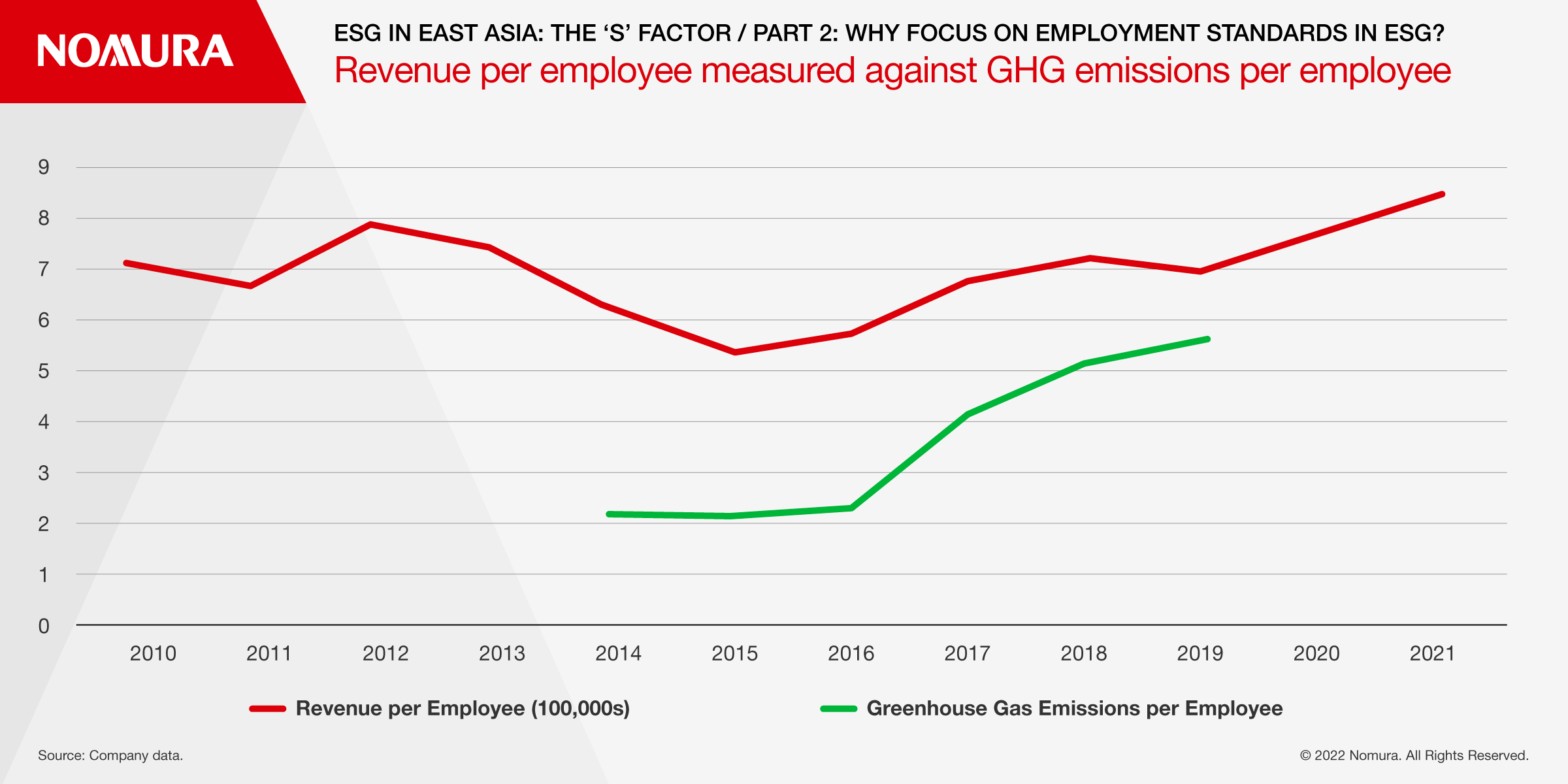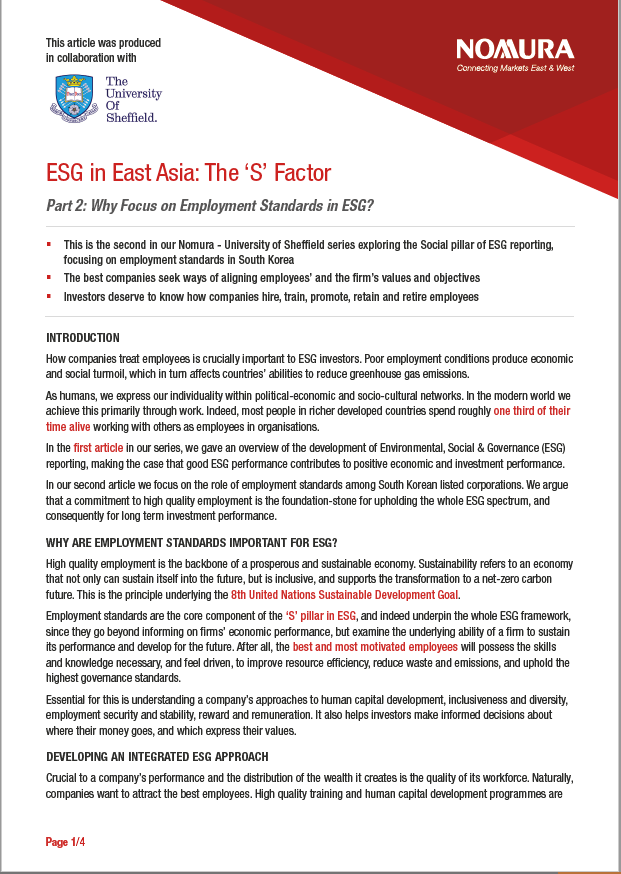Why Focus on Employment Standards in ESG?
Part 2 of our research project between Nomura and the University of Sheffield on the social pillar of ESG in East Asia, highlights how the best companies align employees’ and the firm’s values and objectives.
- This is the second in our Nomura - University of Sheffield series exploring the Social pillar of ESG reporting, focusing on employment standards in South Korea
- The best companies seek ways of aligning employees’ and the firm’s values and objectives
- Investors deserve to know how companies hire, train, promote, retain and retire employees
This article was produced in collaboration with

ESG in East Asia: The 'S' Factor (Part 2)
Introduction
How companies treat employees is crucially important to ESG investors. Poor employment conditions produce economic and social turmoil, which in turn affects countries’ abilities to reduce greenhouse gas emissions.
As humans, we express our individuality within political-economic and socio-cultural networks. In the modern world we achieve this primarily through work. Indeed, most people in richer developed countries spend roughly one third of their time alive working with others as employees in organisations.
In the first article in our series, we gave an overview of the development of Environmental, Social & Governance (ESG) reporting, making the case that good ESG performance contributes to positive economic and investment performance.
In our second article we focus on the role of employment standards among South Korean listed corporations. We argue that a commitment to high quality employment is the foundation-stone for upholding the whole ESG spectrum, and consequently for long term investment performance
Why are Employment Standards important for ESG?
High quality employment is the backbone of a prosperous and sustainable economy. Sustainability refers to an economy that not only can sustain itself into the future, but is inclusive, and supports the transformation to a net-zero carbon future. This is the principle underlying the 8th United Nations Sustainable Development Goal.
Employment standards are the core component of the ‘S’ pillar in ESG, and indeed underpin the whole ESG framework, since they go beyond informing on firms’ economic performance, but examine the underlying ability of a firm to sustain its performance and develop for the future. After all, the best and most motivated employees will possess the skills and knowledge necessary, and feel driven, to improve resource efficiency, reduce waste and emissions, and uphold the highest governance standards.
Essential for this is understanding a company’s approaches to human capital development, inclusiveness and diversity, employment security and stability, reward and remuneration. It also helps investors make informed decisions about where their money goes, and which express their values.
Developing an Integrated ESG Approach
Crucial to a company’s performance and the distribution of the wealth it creates is the quality of its workforce. Naturally, companies want to attract the best employees. High quality training and human capital development programmes are essential for retaining those workers, enculturating them into the firm’s workforce, and building on their creativity, abilities, and enthusiasm for work. The best employees want their work to be meaningful and contributory, but they also want to build a stable and secure future for themselves and their families. The best organizations know this, and seek ways of aligning their employees’ values with the firm’s overall objectives, thereby growing the business and making investment in the firm a financially and ethically worthwhile decision.
For instance, South Korea has an average household size of 2.3 persons, and an age-related dependency ratio of 39.5%. How each company’s income is distributed, what it is spent on, and for what reasons, are therefore important questions for management, the South Korean government, and South Korean families.
At one Korean company, each employee was worth, on average, $698,000 in economic revenue for the company in 2021 - a steady increase since 2015 - and crucially, for the economy and society in which they are embedded. This data shows a strong performance by management and demonstrates the quality of the firm’s employees. But over the same period, greenhouse gas emissions per employee have also climbed, suggesting an environmental cost to the increase in revenue. This is the value of adopting an integrated ESG approach to analyzing corporate performance over the longer term.
However, we know little about the employment standards and conditions that underpin these outcomes. How is the company able to harness higher value from employees? How is the workforce being trained and developed for longer term improvements in productivity? Are these practices environmentally, economically, and socially sustainable? Responsible investors might want answers to some of these questions.
Conclusion
Corporations’ global, national, and local responsibilities begin with how they treat their employees. Listed companies have tens of thousands, even hundreds of thousands, of workers. Most have dependents including children, elderly relatives, and partners. Whole cities are dependent on firms’ economic and environmental sustainability.
Investors, therefore, have a deserved interest in knowing what companies are doing for their employees, how they’re paying them, how they’re hiring, training, promoting, retaining, and retiring them. Indeed, unemployment or poor employment conditions produce economic and social precarity, political instability, and affect countries’ abilities to make the transitions necessary for a low or zero carbon economy.
What ESG reporting does is to allow us to get under the bonnet of a firm’s performance and find out whether its practices are sustainable, inclusive, and just. Here we show the value of placing employment standards as the foundation-stone of an integrated ESG approach to analyzing corporate performance over the long term.
Nevertheless, there are questions regarding the type and quality of data that is included within ESG metrics and frameworks, and what it indicates. In the next article we will look more closely at ESG methodologies.
Download a PDF of the full whitepaper
Contributor

Dr. Peter Matanle
Senior Lecturer, School of East Asian Studies, University of Sheffield

Yejin Shin
PhD Candidate, University of Edinburgh

Jing Wang
PhD Candidate, University of Sheffield

Jim McCafferty
Head of Asia ex-Japan Research
Disclaimer
This content has been prepared by Nomura solely for information purposes, and is not an offer to buy or sell or provide (as the case may be) or a solicitation of an offer to buy or sell or enter into any agreement with respect to any security, product, service (including but not limited to investment advisory services) or investment. The opinions expressed in the content do not constitute investment advice and independent advice should be sought where appropriate.The content contains general information only and does not take into account the individual objectives, financial situation or needs of a person. All information, opinions and estimates expressed in the content are current as of the date of publication, are subject to change without notice, and may become outdated over time. To the extent that any materials or investment services on or referred to in the content are construed to be regulated activities under the local laws of any jurisdiction and are made available to persons resident in such jurisdiction, they shall only be made available through appropriately licenced Nomura entities in that jurisdiction or otherwise through Nomura entities that are exempt from applicable licensing and regulatory requirements in that jurisdiction. For more information please go to https://www.nomuraholdings.com/policy/terms.html.

